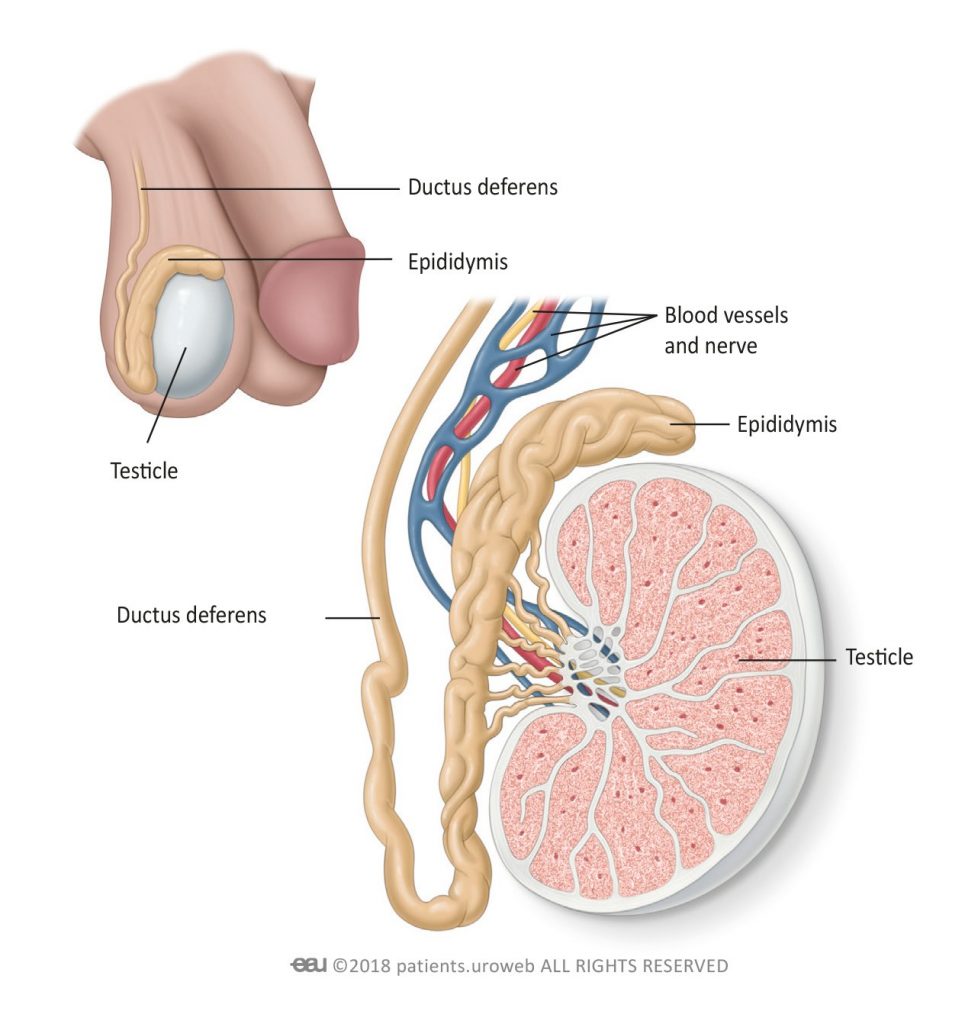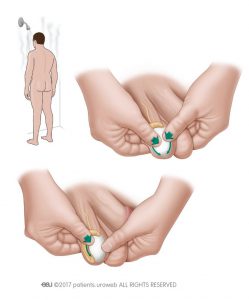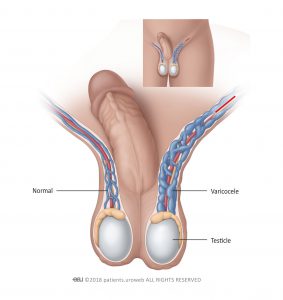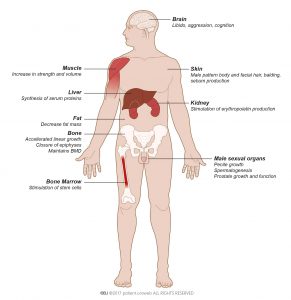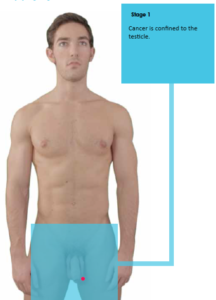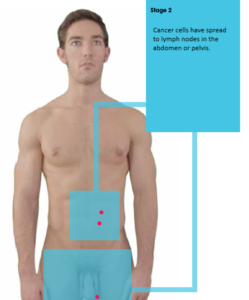The Testicles
The testicles (or testes) are the male sex glands which produce sperm and testosterone, the male sex hormone. They are located outside of the body in the scrotum because sperm develop best at a temperature several degrees cooler than normal body temperature.
The testicles contain structures called seminiferous tubules which produce cells called germ cells. These in turn produce sperm. The sperm move into the epididymis (a tubular shaped structure located behind the testicle), where they are stored and then move into the body through a longer small tube called the vas deferens. With ejaculation sperm are mixed with fluids from other areas (the prostate and seminal vesicles) to form semen (ejaculate).
The testicles are initially formed inside the abdomen and gradually move into the scrotum before birth. In a small number of people this may not happen, and one testicle (or both) may remain in the abdomen. This is described as an undescended testicle. In some cases, the testicle may move into the scrotum. If this does not occur an operation(orchidopexy) may need to be performed. The usual timing of this is at around 1 year of age.
It’s quite normal for one testicle to be slightly larger than the other and for one to hang a bit lower, although the size and shape should be roughly the same.
Testicular Self Examination (TSE)
TSE can identify testicular problems including cancer. It can be performed in a bath or shower when the scrotum is warm and relaxed. Each testicle should be checked separately using both hands (see diagram below). The thumb and fingers can be used to feel the surface of each testicle for any lumps. The epididymis or sperm collecting tube can be felt behind each testicle and will feel soft and spongy.
It is important to understand that most abnormalities men may find when performing TSE will not be testicular cancer. There are non-cancerous conditions which are more common (see below) and can affect different parts of the testicles. A small painless lump within the body of the testicle itself, is more suspicious. Any abnormality needs to be checked by a doctor but most abnormalities will not be cancer.
Non-Cancerous Conditions
Epididymo-orchitis is common in young men aged 15-30. It is a condition where either the epididymis or testis, or both, become inflamed. This is usually caused by infection, either a urinary infection or a sexually transmitted disease (STD). Swelling tends to occur quickly and is painful. It may take several weeks to fully settle. A course of strong antibiotics will usually be prescribed to treat it.
Varicoceles may can affect men of all ages. It is not known exactly what causes a varicocele but the veins in the scrotum becoming dilated, like varicose veins in the legs. Varicoceles can vary in size and are usually not painful but may cause a “dragging” sensation. It is rare for varicoceles to require treatment.
A lubricating fluid within a sac inside the scrotum allows the testicles to move freely. Sometimes clear fluid may accumulate within the sac surrounding the testicle and is called a hydrocele. A hydrocele will often feel like a small fluid-filled balloon and unless large rarely give rise to symptoms. Hydroceles can be surgically repaired or drained if they become uncomfortable or too big. If a hydrocele develops very quickly medical advice should be considered to ensure there is no abnormality of the testicle which may have caused this.
Epididymal cysts usually develop in adults and may take many years to form. These are quite common and are small, fluid filled sacs often about the size of a pea although can be larger. They are smooth and round and found at the head of the epididymis, not in the testicles. Epididymal cysts which contain clear fluid or sperm are not cancerous and generally do not require treatment. Surgical removal may be considered if these become large or cause significant pain.
Testosterone
Testosterone is the male sex hormone and is essential for the development of the reproductive organs and other male characteristics such as:
- Body and facial hair
- Low voice
- Muscle development
- The ability to have an erection.
- Sex drive (libido)
- Stamina
- Mood and wellbeing
Without enough testosterone a man will lose his sex drive, suffer from fatigue, low mood and may gain weight. Testosterone is commonly associated with male aggression but, it is a hormone that helps men deal with the stress and strain of everyday life. Keeping physically fit and avoiding too much fatty fried food, sugar, alcohol and caffeine, all of which can reduce testosterone levels, can keep levels healthy.
Testicular Cancer
Types of Testicular Cancer
Most testicular cancer develops from cells in the testicle which produce sperm (germ cells), and accounts for 95% of testicular tumours.
The most common type of testicular cancer is called a seminoma. This is a slow growing cancer that does not commonly spread to other areas of the body. It is more common in men between the ages of 25-55, with a peak age of 35. A slightly less common type is called non-seminoma and may contain several different types of testicular cancer including a rarer type known as teratoma. Non-seminoma tends to affect men between the ages of 15-35, with a peak age of 25 years old.
Other rarer non germ cell tumours account for only a small percentage of testicular cancers. In addition, 4% of men with a type of blood cancer (lymphoma), may also develop testicular swelling.
Staging
Staging is a term used to describe how far cancer cells may have spread within the body. It helps determine the best type of treatment. The most common way of describing the stage of cancer is called the TNM system and is based on the results of the surgery, scans, and blood tests.
This can be between 1 – 4 indicating how big the area of cancer is within the testicle.
| T0 | No cancer. |
| Tis | Cancer cells are within the testicles. |
| T1 | Cancer cells are confined to the testicle and epididymis. |
| T2 | Cancer cells have begun to spread to blood vessels or lymph nodes close to the testicle. |
| T3 | Cancer has grown as far as the spermatic cord and possibly to some blood vessels and lymph nodes. |
| T4 | Cancer has invaded the scrotum. |
Lymph nodes are small oval shaped structures found all over the body which filter unwanted substances. As cancer cells spread, they can become trapped in lymph nodes.
| N0 | No lymph nodes contain cancer. |
| N1 | Lymph nodes are smaller than 2cm wide. |
| N2 | At least one lymph node is larger than 2cm but smaller than 5cm wide. |
| N3 | At least one affected lymph node is bigger than 5cm. |
This means cancer which has spread to other areas of the body.
| M0 | The cancer has not spread to other organs. |
| M1a | The cancer has spread to the lungs or distant lymph nodes furthest away from the testicle. |
| M1b | Organs such as the liver or brain have been affected. |
The results of blood tumour markers can also be added to this system.
|
Testicular cancer can also be divided into three stages.
- Stage 1: Cancer is confined to the testicle
- Stage 2: Cancer cells have spread to lymph nodes in the abdomen or pelvis
- Stage 3: Cancer Cells have spread to other organs in the body

